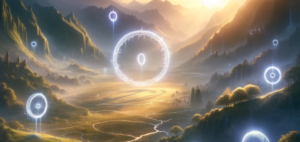The upcoming film “Lord of the Rings: The Hunt for Gollum” is set to delve into previously unexplored storylines within the Middle-earth saga. Directed by Andy Serkis, who famously portrayed Gollum, this film promises to offer a new perspective by focusing on the character of Gollum before the main events of “The Lord of the Rings.”
The narrative could potentially explore Gollum’s life after he loses the One Ring to Bilbo Baggins, his descent into obsession, and his relentless pursuit to reclaim it. This premise allows the film to deepen the understanding of Gollum’s complex character—his dual nature and struggle between his Smeagol and Gollum personas—while weaving in his interactions with various inhabitants of Middle-earth.
Additionally, since Peter Jackson, Fran Walsh, and Philippa Boyens are involved in the project, the film is likely to retain the epic storytelling and aesthetic continuity with the original series, promising a rich visual and narrative experience that respects Tolkien’s detailed world-building.
Gollum, originally known as Sméagol, is one of J.R.R. Tolkien’s most intricately drawn characters, embodying the tragic consequences of obsession and corruption. Born a Stoor, one of the three early Hobbit-types, Sméagol was ensnared by the One Ring’s power on his birthday, when he murdered his relative Déagol to claim it. This pivotal moment initiated his transformation into Gollum, a name derived from the guttural, swallowing sound he made. The Ring extended his life far beyond natural limits, twisting his Hobbit form and mind into something dark and pitiable. Over centuries, the Ring’s influence rendered him a creature of shadows and riddles, driven by the schizophrenic tug-of-war between his remaining vestiges of Hobbit-like kindness and the malevolence wrought by his ‘Precious.’
Living in dual exile, both self-imposed and forced upon by his community, Gollum’s story is marked by his periods of dwelling in dark, lonely places like the Misty Mountains and the Dead Marshes. His character arc intricately weaves through the legendarium, providing critical intersections with the main narrative of “The Lord of the Rings.” After losing the Ring to Bilbo Baggins, Gollum’s life became a relentless quest to reclaim it, leading him to Frodo Baggins. Despite moments of near-redemption, influenced by Frodo’s kindness, Gollum’s story culminates in his tragic end in the fires of Mount Doom, where his obsession inadvertently leads to the destruction of the Ring. This conclusion serves not only as a poetic justice but also underscores Tolkien’s themes of fate, free will, and the redemptive power of mercy.
The One Ring, central to J.R.R. Tolkien’s epic, is a symbol of absolute power and the corruptibility it brings. Forged by Sauron in the fires of Mount Doom during the Second Age of Middle-earth, the Ring contains a substantial part of his malevolent spirit, crafted to dominate the wills of the other Rings of Power and their bearers. It is unique, not only for its ability to confer invisibility but also as a tool of enslavement and manipulation, enhancing and exploiting the bearer’s desires and fears. Over millennia, the Ring’s influence extends beyond mere physical possession, creating ripples that affect the fates of individuals and nations. Its very existence is enough to spark wars and shape the geopolitics of Middle-earth, illustrating Tolkien’s exploration of power’s seductive and often destructive nature.
Throughout “The Lord of the Rings,” the Ring is almost a character unto itself, with its agency manifesting in its seeming ability to influence events and decisions, such as its ‘decision’ to abandon Gollum when the time was ripe. Its journey from Sauron to Isildur, and through various hands, until it reaches Bilbo and Frodo Baggins, underscores its perilous allure and the heavy burden it represents. The narrative arc of the Ring culminates in the climactic moment of its destruction, an act that not only requires Frodo’s heroic sacrifice but also Gollum’s tragic intervention, signifying Tolkien’s complex dialogue on fate, free will, and moral ambiguity. This destruction also symbolizes the collapse of a tyrannical regime and the liberation from a cyclical legacy of despair, aligning with Tolkien’s broader themes of renewal and hope in the face of overwhelming darkness.
Gollum’s intricate narrative from J.R.R. Tolkien’s legendarium sets the stage for “The Hunt for Gollum,” a film that seeks to delve deeper into his tortured existence and pivotal moments before the main events of “The Lord of the Rings.” This new exploration is poised to shed light on Gollum’s psychological and physical journey as he grapples with the loss of the One Ring and his descent into a creature driven by obsession. As a character who embodies the tragic conflict between his former Hobbit-self, Sméagol, and the Gollum persona created by the Ring’s curse, this film offers a unique opportunity to explore themes of identity, addiction, and redemption, set against the richly woven backdrop of Middle-earth’s darker corners.
With Peter Jackson and his team of Fran Walsh and Philippa Boyens at the helm, alongside Andy Serkis not only reprising his role but also directing, “The Hunt for Gollum” promises to be a faithful continuation of the Middle-earth saga. Their collective vision is likely to respect Tolkien’s original storytelling while introducing new nuances to the character of Gollum. This film will potentially enrich the existing narrative, providing fans and scholars alike with deeper insights into one of Tolkien’s most complex characters, whose fate is inextricably linked to the Ring’s own dark legacy. As audiences anticipate this new chapter, the enduring themes of Tolkien’s world—power, corruption, redemption—are set to captivate a new generation, continuing the legacy of one of fantasy’s most enduring tales.
